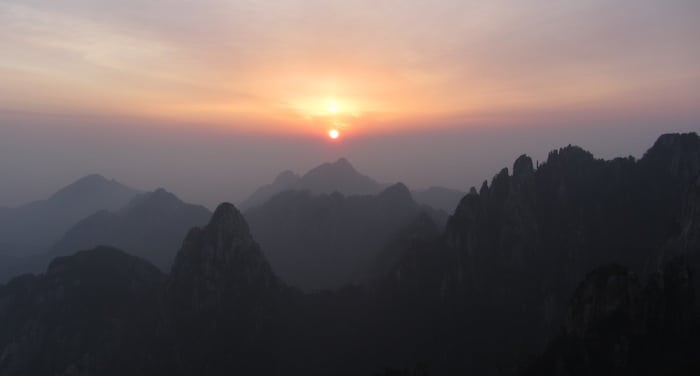 Sunrise at Huang Shan
Sunrise at Huang Shan
The Yellow Mountain (Huang Shan, 黄山) is among the most visited sites in China for those looking for a unique natural landscape. It’s not for nothing that the site is protected by UNESCO and tourists swarm at all times of the year.
There is therefore a rightful premise about it: if you’re a tourist habitué in China, it’s no longer the crowds that scare you, you know that Huang Shan is capable of dazing even the most prepared, above all during the holidays.
If instead you landed in the Middle Kingdom and have half an idea of beginning with this stop, I recommend that you start with other places so that you can gradually get used to the immensity of Chinese numbers (for example, a stop in Shanghai, Hangzhou or Nanjing).
In fact, the attraction of the Yellow Mountain is such that I saw a kilometer-long line at the entrance to the cable car, with desperate Chinese women in tears and families packed like sardines; but I have also seen young men fighting over what seemed to be the last hotel room left on all mountain peaks, when the darkness was already thick and the only alternative solution was to sleep on the hotel carpet (because the couches were already occupied).
Therefore, it’s better to prepare for the trip by reading this guide.
The Yellow Mountain (Huang Shan, 黄山)
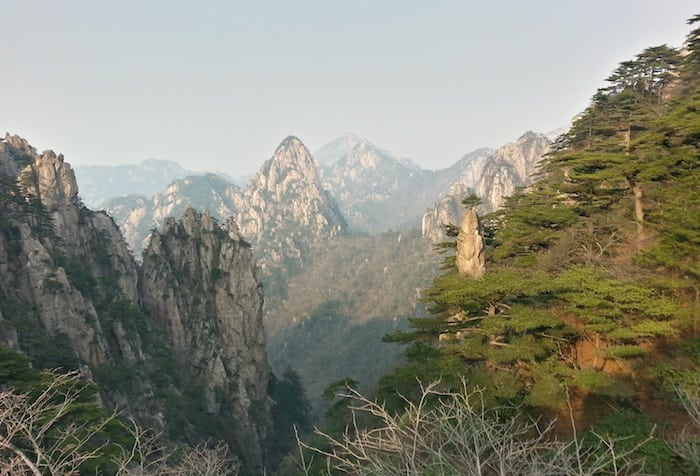 The panorama of Huang Shan
The panorama of Huang Shan
Huang Shan is a granite chain formed by numerous heights, of which over seventy exceed 1.000 meters. The landscape is unique thanks to the rocky shapes between the steep and barren, the sanded and smooth; the vegetation is just as characteristic and on the slopes of the mountain the pines form rather strange designs.
Its fame is was nevertheless energized by the art (literary and pictorial) that have placed these landscapes at the center of its production: Li Bai, one of the most renowned classical poets in China, spoke of its marvels, while the Shanshui painting school have rendered these panoramas representative of China for a long time.
The highest peaks of Huang Shan are Lian Hua Feng (莲花峰) or Lotus Peak (1,864 meters), Guang Ming Ding (光明顶= or Brightness Top (1.840 meters) and Tian Du Feng (天都峰) or Heavenly City Peak (1,829 meters).
The Yellow Mountain is entirely walk-able even for non-expert climbers because the designated paths are all carved from the rock and are more or less stairways. Therefore Huang Shan is normally faced with “social types”: women with high heels, pregnant ladies, babies in diapers, really old elderly people that often fall back to get picked up by locals in sedans.
That notwithstanding, one needs to keep in mind that although there are cable cars that service the heights, if you want to enjoy a little bit of the panorama you can’t help but walk. Or better, climb the stairs.
How to get to Huang Shan
The site is so famous and visited that today Huang Shan is connected by high speed trains from:
- Shanghai (5 hours on the G1509, leaving in the morning at 8.27);
- Beijing (there are fast trains from 8 in the morning to 15.30, and the trip lasts a little under 7 hours) and on the same line, Tianjin;
- Guangzhou (the G636 leaves at 9.12 AM and takes 7 hours);
- Xiamen (departures from 7 to 15, a little less than a 4 hour trip);
- Hefei (continuous connections form morning until night lasting about and hour and a half).
From other cities K lines depart, or slow trains. There are also long distance buses and VIP buses, from/to Suzhou, Hangzhou, Wuhan, Ningbo and others.
Huang Shan is also reachable by air; the Huangshan Tunxi International Airport is really close to Huang Shan city (actually called Tunxi). There are internal flights from major cities already reachable by rain, and also from Chengdu, Chongqing and Shenzhen.
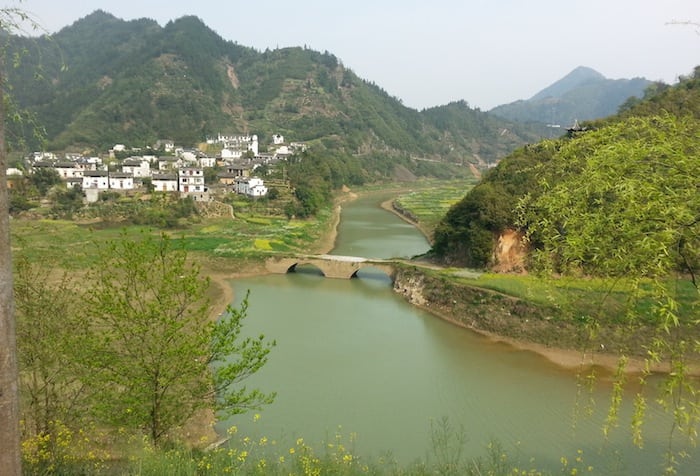 The countryside of Anhui
The countryside of Anhui
Huang Shan is located in the western part of Anhui province, so from Shanghai it’s a distance of about 400 km, 360 km Nanjing and 250 km from Hangzhou, which makes it accessible also by car via the large and clear Chinese roads. Some of the most beautiful country views I’ve seen during my stay in China I saw thanks to this trip on the road between the provinces of Jiangsu and Anhui.
The driving solution is a card that’s always spendable in China, if you don’t find valid alternatives to public transport or you want to cross a less contaminated part of China; for private drivers, it’s always easier to turn to a hotel which has these types of contacts and can help those who don’t speak Chinese.
From the city of Huang Shan, where long distance options arrive, shuttles depart for Tangkou (汤口), adjacent to the entrance to the Park, at the foot of the mountain. If you choose to climb on foot, the climb starts at Tangkou. If instead you’re going for the cable cars, there are shuttles that connect directly to the station, airport and the city of Tangkou obviously. These city buses don’t cost more than 20 Yuan for the longest trip. Even taxis and tuk tuks are available if you arrive from the airport or station, but to get to the cable cars you can only use designated buses.
Visiting Huang Shan
Yellow Mountain means stairs. We’re talking about 50 km of stairs. And this means calves of a rhinoceros, even if you’re very fit and have climbed Everest. The trekking that we’re used to has nothing to do with hours and hours of stairs, for those who descend and climb. So if you’re going to Huang Shan, bring some wolfbane for nightly massages and Polase to avoid cramps. And prepare to suffer.
It is possible to climb Yellow Mountain in a single day of exclusive trekking, but you’ll obviously miss out on the sunrise, the sunset and almost surely a good part of the peaks because the distance to cover between one and another are extensive. Personally I find that it’s the wrong choice for Huang Shan, while it’s more doable for Hua Shan, in Shaanxi (another of the Sacred Mountain that I recommend for you to visit).
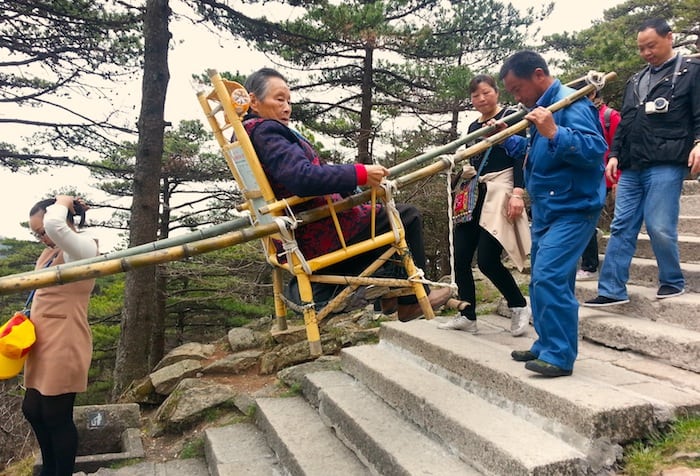 The porters
The porters
Nevertheless, if you intend to do a day trip, for just the trip up and down on foot count on at least 10 hours of walking, passing from the eastern staircase and returning from the western one. Alternately, you can consider using the cable car.
You can in fact take advantage of the cable car for the ascent and descent and limit the walk to the top and different peaks; in this case the excursion will be more manageable. There are two cable car lines to get up, the one that leaves from the temple of Yungu (云谷寺站) and the other towards the west (Mercy Light station, 慈光阁站). The most used one is the first since it arrives at the heart of the complex.
The cable cars operate at various hours depending on the season, but they follow the light, so in winter the last trip is in mid-afternoon. The cost of the cable car is separate from the park entrance: the round trip will cost about 80 Yuan. The entrance to the park is more expensive in high season (more than 200 Yuan) and less expensive in summer.
The best solution, and also the most popular for organized groups, is the climb and visit the first day, overnight at the top, then the sunrise and visit the second day and the trip down. Even three days are doable if you have the time and want to even enjoy the western parts that are less visited.
Here are some simple itineraries that I recommend, for which you can make your own adjustments:
2 days:
- day 1: climb by the eastern path or Yungu cable car; visit to the peaks and walk to the north; spend the night on top
- day 2: sunrise, descend to Tangkou by the western path or with the Yuping cable car
3 days:
- day 1: climb by the eastern path or Yungu cable car; visit to the peaks and walk to the north; spend the night on top
- day 2: visit to the Illusion Scenic Area (梦幻景区); spend the night on top
- day 3: sunrise, descend to Tangkou by the western path or with the Yuping cable car; visit the villages of Huizhou
4 day:
- day 1: climb by the eastern path or Yungu cable car; visit to the peaks and walk to the north; spend the night on top
- day 2: visit to the Illusion Scenic Area (梦幻景区); spend the night on top
- day 3: sunrise, descend to Tangkou by the western path or with the Yuping cable car; visit Xidi (西递) and Hongcun (宏村), spend the night in Hongcun (or viceversa)
- day 4: visit the villages of Chengkan (呈坎) and Shexian (歙县).
Note that if you decide to skip the cable car up or down, the times will be longer and the schedules will become a little tighter.
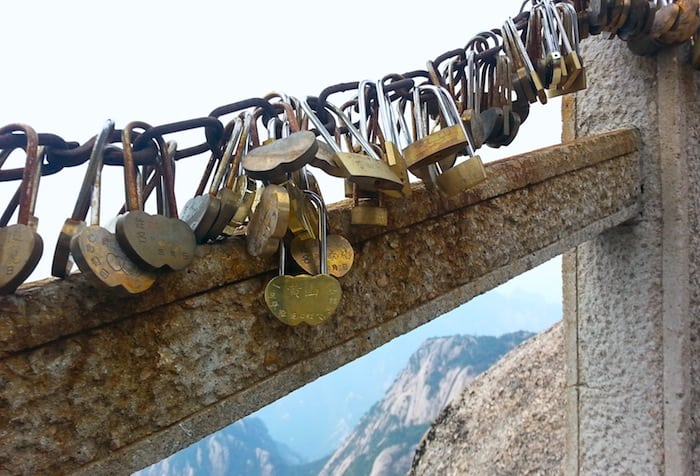 the locks on Huang Shan
the locks on Huang Shan
As far as the course to follow on top: the glimpses of the panorama are as numerous as the “photographic” balconies, you’ll just have to do a little slalom between people’s heads and the…locks of lovers attached to the chains.
There are points in which the rock formations assume curious shapes: the Chinese are great at inventing poetic names that when translated to English are much less elegant. In any case, following the path of stairs routed to “touch” the highest peaks (at least the open ones, since some are not accessible), you’ll pass all noteworthy zones.
Rocks in the shape of turtles, masses suspended in the middle of small cross-able ravines, trees that sprout up in the most unimaginable places. Any of the maps provided at the entrance to the park will help you keep track of both the paths and marvels of Huang Shan.
Spending the night: where and how
The hotels on the top of Huang Shan are for now the most expensive that I’ve encountered in my travels in China. Moreover, they’re heavily booked, so there are many problems tied to this unending turn-over, not least the fact that they fill rapidly and are difficult to keep as clean as they need to be.
Click here to read of a review of the most popular ones.
In addition, click on the following link to find a hotel in Tunxi, Tangkou or near the airport.
I won’t recommend the paradise where I stayed because… my story is one to forget: having waited until the last minute to book lodging, I found the best choices were obviously already taken, and I opted instead for a bed in a so-called “dormitory”. I was in the dark as to what it meant, and where I wound up will be a lesson to you for your future visit.
The hotel reception left much to hope for, it’s a shame that once I checked-in I was escorted to the back of the building and parking lot into a container with packed bunk beds without a minimum of services (for example, electric sockets). The bathrooms were outside, with Turkish toilets closed-in by dangling doors, laundry in the open air (romantically under a starry sky…) and naturally, in this comfortable room the only form of heating was human breath.
When at three in the morning the young Chinese tourists began getting up to prepare for the sunrise and conquer a first spot in line, in our luxury container penguins and polar bears came in.
Therefore, my advice is to be wary of berths for 200 Yuan, so long as you don’t want to live under Spartan conditions. On the contrary, to not get stuck with a room for over 1000 Yuan, book way in advance. It’s absolutely necessary, especially if you travel in high season and during national holidays, that recommendation also goes for the train. I received a report that the hotel close to the Yungu cable car, the first on the Lonely Planet guide’s list, is no longer there. So forget about it.
I repeat, here you’ll find a list of the most popular hotels.
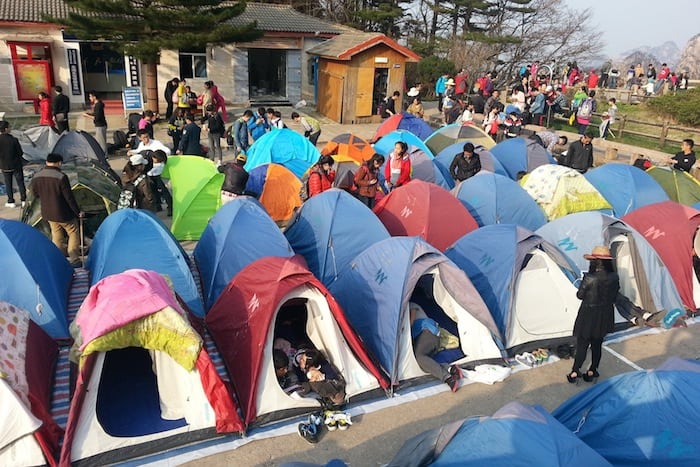 The campsite
The campsite
There’s the camping solution, if you prefer: now, what’s hidden behind a rented tent separated from the green meadows with grazing cows, is the cement encampment where your neighbor’s feet are tangled with yours. Even as far as tents go, be careful. You can also choose to camp at the top on your own, but I never saw organized sites so it’s better to check with the hotels in Tangkou before taking the risk. In any event, the average expense for a tour of Huang Shan is higher than all the rest of China; keep it in mind.
As far as Tangkou goes, this is the ideal place to spend the night before your ascent because, as was mentioned, it’s only about a kilometer from the entrance. Tangkou lives on tourism headed to Huang Shan, so it is really well-stocked in lodging, restaurants and shops for morning refreshment. They also offer equipment for expert climbers, such as staffs, disposable hats and high quality canteens.
It’s best to stock up on provisions in the valley (for what you can) because on top they cost as much as gold: besides, when you see who brings supplies up the stairs and how much time it takes, it will be clear why they’re so precious.
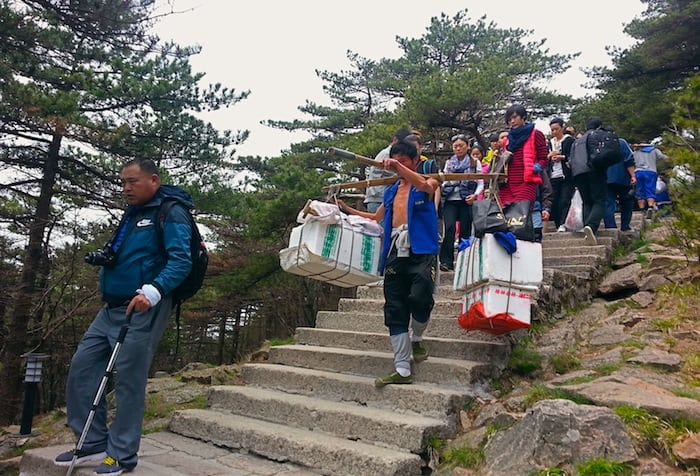 The porters
The porters
Various arrangements
1: Watch the weather
Let’s dispel the false rumor that says Huang Shan is beautiful all year long. It’s not true! The Yellow Mountain is beautiful when you see something, so days of dense fog should be avoided, the same with rainy days. But this, really, is just good sense for any trip to the mountains. The risk is getting stuck in scenery like the one shown in the photo…
 Fog on Huang Shan (Photo by Antonello Cerrito)
Fog on Huang Shan (Photo by Antonello Cerrito)
Clearly it isn’t possible to know exactly when the top will be foggy, since the mist is very very frequent, and anyway, to a reasonable degree, it confers an incomparable fascination to these landscapes. However, you can avoid the summer season where the possibility of rain is higher, and the winter with snow that usually brings mists. After all, it’s only a question of luck. I know, you’re thinking that I’m crazy: on one hand you should book in advance, on the other you should consult with a weatherman, which up until the last minute is not reliable. The truth is that against the fog of Huang Shan there’s little that you can do, and to a great degree it’s luck that determines the success and pleasantness of the climb. On this, any guide or wise advice has no power.
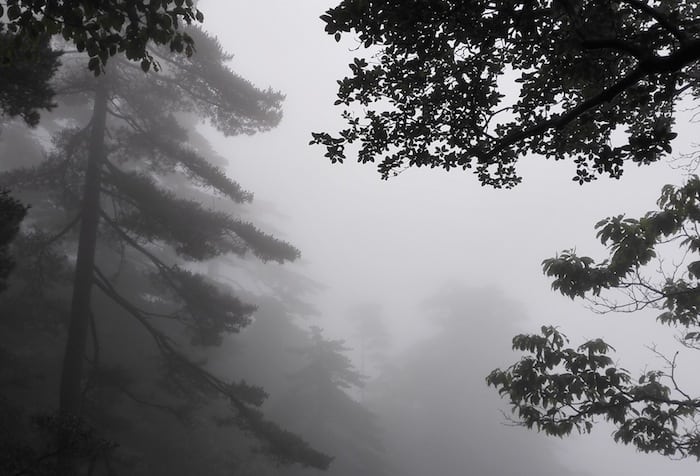 Misty panorama of Huang Shan (Photo by Antonello Cerrito)
Misty panorama of Huang Shan (Photo by Antonello Cerrito)
2: How to see the sunrise
A visit to Huang Shan is not complete if it’s not possible to enjoy the sunset and sunrise from the top. Despite a favorable position, or high mountain, you’ll find that it has never been so difficult to find a spot free of the heads of other tourists. The sunrise is an event, on clear days, that unleashes the race to the best places to see it. People will climb everywhere just to take their picture and post it on social media.
The only reason that I personally managed to see the sun rise is because I dared to go where others didn’t: I actually entered through a closed gate and got myself up on a peak prohibited to the public. Clearly, don’t do this, it is absolutely not recommended and dangerous, but that time it worked.
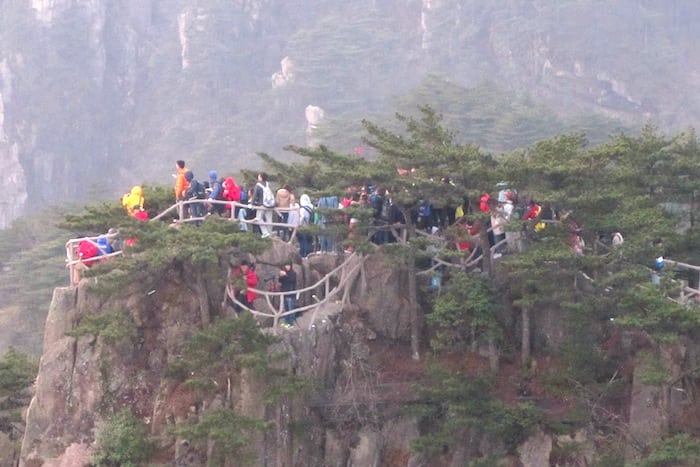 The crowd at sunrise
The crowd at sunrise
The solution to rectify this inconvenience is:
- choose a day during low season
- wake up well before the sunrise (see my roommates and their polar bear friends)
- ask a professional friend to accompany and take pictures of you
3: Choose the day
Now we come to the next questions. As I said above, you should at all costs avoid the red days on the calendar. If you have no choice but to go during those times, then I recommend you be as cunning as possible.
For example, if you can choose, go up on a vacation day. If you take the cable car for the ascent, do it really early, at opening would be best, or in the evening when the sun goes down, in order to postpone the excursion to the next day. On the way down, again, go down before 8 in the morning or toward closing time. The wait time for the cable car lines can reach biblical proportions…you too may burst into tears as the victim of Chinese crowds!
In any event, if you have the time, my advice is to take it easy and climb on foot: this way you’ll find almost no one on the road because the Chinese rarely walk more than what’s strictly necessary.
After Huang Shan: the Huizhou villages
This is a good chance to take advantage of a trip to Huang Shan for a tour of the Huizhou villages. They are areas with a very particular history and especially unique architecture, to the point that they are inscribed on the World Heritage list.
The villages are numerous, but if you don’t have time and must make a choice, then Xidi (西递) and Hongcun (宏村) are for you: they’re not far from the Huang Shan area and are reachable by bus from both Huang Shan and Tangkou, these are the bamboo forest battle zones from “The Tiger and the Dragon”.
Other notable sites are Chengkan (呈坎) to the north of Huang Shan, and the large center at Shexian (歙县), further off to the east.
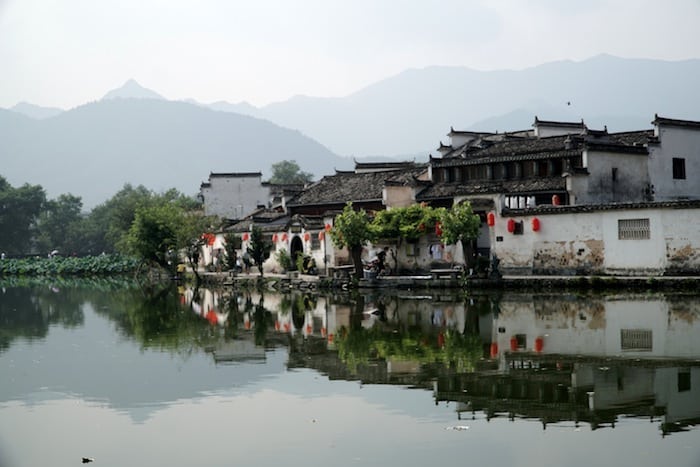 The village of Hongcun
The village of Hongcun
Entrance fees are required for the villages, sometimes in cash. But, what’s more, once it becomes a World Heritage Site, it isn’t rare that Chinese sites speculate a little on the entrance fees. Regardless, the villages preserve architecture that goes back to the XIV century, that is for the most part intact. The Huizhou villages were built by merchants that left young for work only to return only once a year, spending their fortune to beautify their village and build temples.
The bus that leaves the Huangshan bus station arrives in Hongcun passing through Xidi; the runs are more frequent during the morning, in the afternoon they stop at about 15, and are very economical like most buses in general. While the villages are well connected, the best way to reach them are by car, with a private driver and on your own (especially if you don’t speak Chinese).
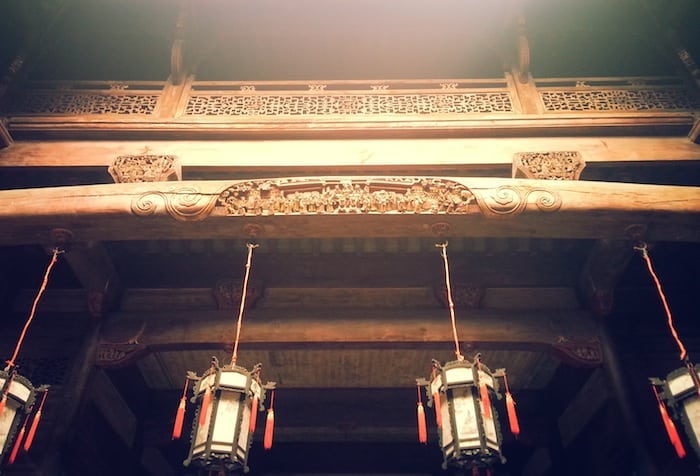 A detail in the architecture of Xidi
A detail in the architecture of Xidi
The towns are about an hour and a half from Huangshan so it’s also possible to consider a day trip. Nevertheless, the pedestrian streets and atmosphere of the Huizhou villages, inlaid with little bridges and narrow, intimate alleys, invite visitors to spend a night in one of the hostels or hotels that fill the area.
Be aware that the entrance ticket to the villages is good for one day with no specific hours, unless you get a multi-day ticket. In the evening, the entrance is free, and you can pass through the village, sit in one of the thousands of little restaurants and taste the delicious vegetables of the region.
Now, nothing and no one can stop you from reaching the most coveted peak in China. But if you still have doubts, or simply want to share the leg pain that you suffered, leave a comment and follow!
Photo Credits: Photos by Rita Andreetti



